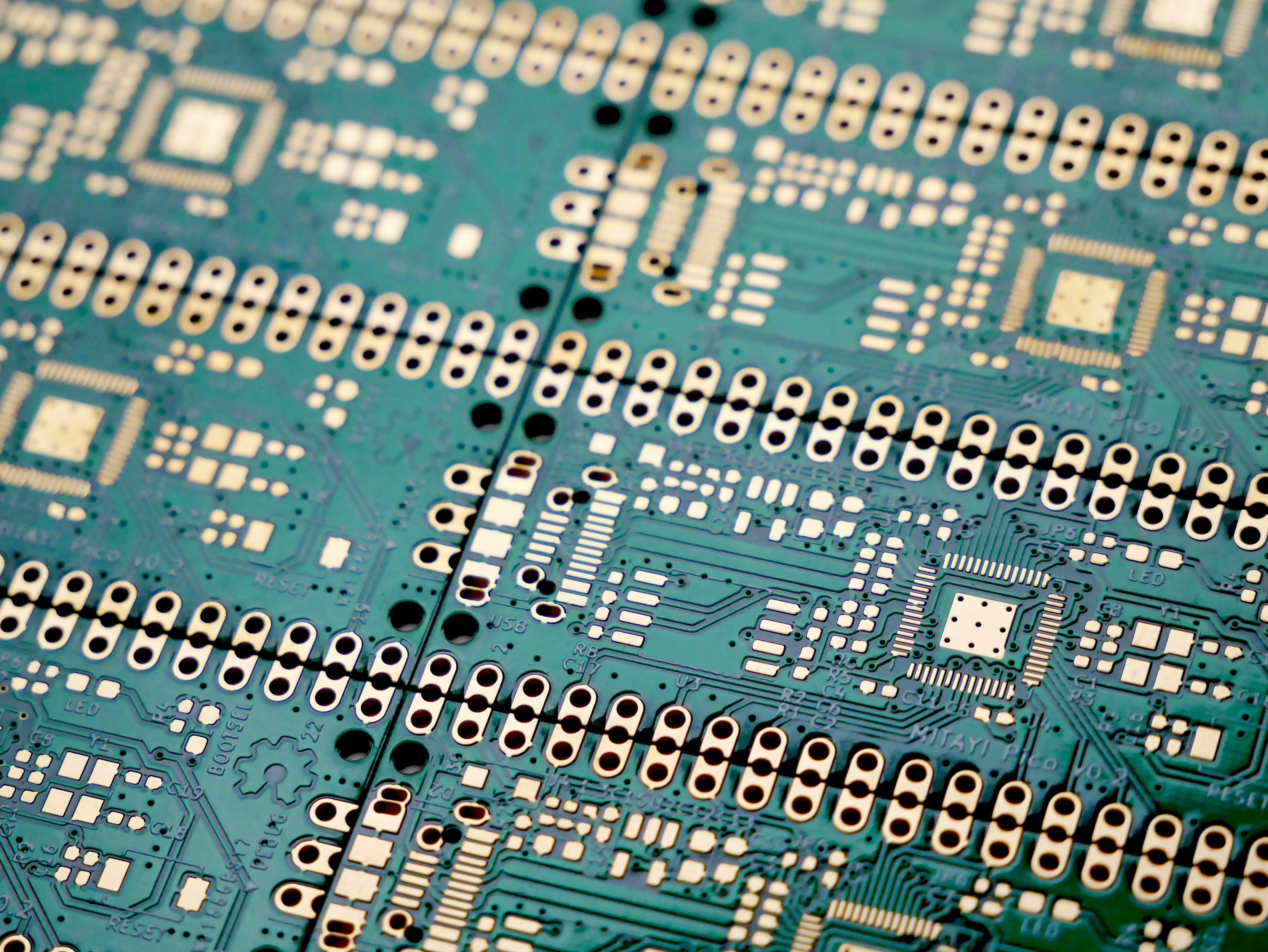

Jason Love, Professor of Molecular Inorganic Chemistry, reveals innovative ways researchers are tackling the major sustainability challenges of the ever-growing demand for electronics.
Increasingly high-technology lifestyles have resulted in economic, scientific and societal challenges in supply, demand and use of finite global resources such as metals, minerals and fuels. Current linear manufacturing processes which extract, process, exploit and dispose of these resources are being challenged, with a greater impetus towards circularity in material and resource use. Bold approaches are required that provide sustainability and circularity in our resource use and I believe that ideas and initiatives from the chemical sciences can provide impactful circular solutions to these substantial challenges.
This article will highlight research themes and examples from the School of Chemistry that aim to tackle sustainability in resource generation and exploitation. This is a wide-ranging explorative landscape within the School and the following analysis is not comprehensive, so will highlight sustainability and circularity in terms of the recycling of electronic waste.

A growing challenge
The use of electronics in technology is unrelenting. If we consider the automotive industry, the advances occurring in low-carbon transport, for example, by battery-powered vehicles all require up-to-date electronic components and management systems. Ultimately, it is envisaged that autonomous vehicles will become mainstream, for which computerised control systems will abound. All electronics rely on an enormous variety of metals for their long-lived operation: gold is used to ensure good electrical contact between components; copper is the mainstay of electronic circuitry; tantalum is an essential component of capacitors. While the global electronic waste market is worth $50 million a year [1], recycling rates are derisory with less than 5% of tantalum recycled, even though it arises from a conflict mineral [2]. To achieve resource circularity, there is a clear need to deliver formal and environmentally benign metal recycling pathways, and chemical insight and ingenuity is integral to this challenge [3].
The recycling of metals from electronic waste is being studied by my group with Professor Carole Morrison from the School of Chemistry and Professor Bryne Ngwenya from the School of GeoSciences. Recently, this team described a new chemical reagent that can precipitate gold selectively from electronic waste that is dissolved in acid [4]. The reagent is not only highly selective towards gold, but the conditions can be tuned such that different metals such as tin, gallium and platinum can be targeted and separated in the precipitation process. This significant advance in metal separations technology could be exploited in existing e-waste recycling processes, precious metal refining and other economically and/or environmentally important separations [5].
Keeping metals in use
Furthermore, in collaboration with the environmental remediation company SEM Ltd and e-waste collectors WEEE Scotland, the marrying of chemical metal separation processes by the Edinburgh team with biological effluent remediation was shown to be feasible [6]. The development of holistic recycling processes is important and this study has shown that waste can be minimised through the application of different chemical and biochemical approaches.
Metals derived from e-waste can be used as precursors for catalytic chemical reactions [7]. Chemical catalysis is inherently circular yet is dominated by the use of expensive, low-abundance metals such as palladium and iridium. While these metals can be recycled from e-waste and other secondary resources, the inter-university doctoral training frameworks of CRITICAT and EaSI-CAT have encouraged the rethinking of catalyst design [8]. Dr Stephen Thomas has shown that base metals such as manganese and iron can be exploited as catalysts in reactions to deliver complex organic molecules or soft plastics to pharmaceutical and polymer industries and that these are as effective as more expensive, precious-metal catalysts [9]. Professor Michael Ingleson and Dr Michael Cowley have shown that highly abundant, and traditionally ‘catalytically irrelevant’, metal and non-metal compounds of aluminium, zinc and boron can undergo reactions analogous to precious metals [10]. These examples highlight a diversity of applications for compounds in catalytic processes and the intrinsic move towards greater sustainability and circularity that the chemical sciences can provide.
The re-use of metals is also being investigated in a highly collaborative project involving my research group and jewellers, designers and metallurgists from the Duncan of Jordanstone College of Art & Design in Dundee, the National Institute of Design in India and the Indian Institute of Technology at Banaras Hindu University. This project aims to exploit chemical recycling techniques to separate gold and copper from e-waste to provide female artisanal jewellers in India with an alternative and sustainable supply of recycled metals. India is an enormous collector of e-waste, much of which ends up being recycled informally and hazardously, so the re-use of e-waste would have significant environmental, health and societal benefits.

The plastic problem
While the primary value for recycling e-waste results from extracting the myriad metals, a considerable amount of material such as glass fibre and plastics remain. These composite materials are difficult to handle and are instead used to provide energy to metal recycling processes that use smelters [11]. It would, of course, but much more attractive to recycle and reuse these materials, and efforts are underway in the School to accomplish this.
Dr Caroline Kirk is looking at ways of incorporating circuit-board laminates and other composite materials from e-waste as fillers in cement. This would lessen the impact of producing cement and make use of ready-made waste. However, a chemical understanding of the interactions between the filler and bulk material is required through spectroscopic and diffraction studies, e.g. synchrotron diffraction, to ensure that material coherence is maintained [12]. Caroline is also investigating the formation of useful composite battery and capacitor materials directly from mixtures found in e-waste.
Plastics have become synonymous with chemical wastes. Plastics such as polyethylene are very long-lived in the environment and when blended with other materials are difficult to recycle. However, Dr Jennifer Garden is investigating bioderived and biodegradable alternatives to conventional plastics, underpinned by the development of new catalysts [13]. These polymers can be broken down into oligomer/monomeric chemicals in order to be able to re-use them in polymerisation processes. Her research also seeks to improve recycling processes by developing “chemical zips”, which combine mixtures of plastic into a hybrid material with improved properties. This has the potential to enable mixed-plastic waste to be upcycled into value-added materials.

Power generation and storage
No circularity in manufacturing processes can be achieved without added energy input, and this energy needs to be sustainable and not derived from fossil sources. Solar energy capture by photovoltaics will increasingly contribute to the energy sector as the daily global energy provided by the sun (insolation) equates to that used annually in human endeavours. The development of new photovoltaic materials such as those found in dye-sensitised and perovskite solar cells is being investigated by Professor Neil Robertson who has developed, for example, a very low-cost and simple procedure for easier fabrication of dye-sensitised solar cells [14].
The exploitation of sustainable energy sources remains problematic due to difficulties in storing the energy for when it is needed; solar energy is diurnal and energy capture by wind turbines is intermittent. Energy storage could be achieved through battery banks, although this creates supply issues for the lithium required to manufacture batteries, many of which are very poorly recycled. An alternative is to store this intermittent energy through the use of heat batteries. Professor Colin Pulham, in collaboration with the heat-battery designer and manufacturer Sunamp, is leading the way in understanding and improving the phase-change materials that are integral to their effectiveness. The company’s range of heat batteries for the residential market provides a low carbon, reliable, space-saving alternative to traditional hot water cylinders, safely cutting energy consumption and fuel costs [15].
Chemistry and collaboration
Significant challenges in the material supply, manufacture and recycling for advanced, high-tech materials abound and the shift from linear to circular practices requires a complexity of technological, environmental and societal advances. I hope to have shown that the chemical sciences can provide inventive and practical solutions to some of these issues and that this theme is integral to the research ongoing in the School of Chemistry. While, in my opinion, chemistry is centrally positioned to champion material sustainability and circularity, collaboration between the physical and natural sciences, social sciences and industry will provide the best opportunity to deliver impactful research in this area.
Discover how we can help you develop innovative ideas and deliver solutions for People Places Planet.
A new separation and recovery process for refining and recycling metal
[1] V. Forti, C. P. Baldé, R. Kuehr and G. Bel, The Global E-waste Monitor 2020: Quantities, flows and the circular economy potential.
[2] European Commission: Critical raw materials fact sheets.
[3] M. D. Rao, K. K. Singh, C. A. Morrison and J. B. Love, RSC Adv., 2020, 10, 4300.
[4] L. M. M. Kinsman, B. T. Ngwenya, C. A. Morrison and J. B. Love, Nat. Commun., 2021, 12, 6258.
[5] L. M. M. Kinsman, B. T. Ngwenya, C. A. Morrison and J. B. Love, UK Patent Application PE961477GB
[6] https://www.chem.ed.ac.uk/news-events/news/researchers-turn-electronics-trash-treasure-help-dram
[7] S. McCarthy, A. Lee Wei Jie, D. C. Braddock, A. Serpe and J. D. E. T. Wilton-Ely, Molecules, 2021, 26, 5217.
[8] https://www.criticat.co.uk
[9] J. H. Docherty, J. Peng, A. P. Dominey and S. P. Thomas, Nat. Chem. 2017, 9, 595.
[10] M. E. Grundy, K. Yuan, G. S. Nichol, M. J. Ingleson, Chem. Sci. 2021, 12, 8190; S. A. Iqbal, J. Cid, R. Procter, M. Uzelac, K. Yuan and M. J. Ingleson. Angew. Chem. Int. Ed., 2019, 58, 15381; D. R. Willcox, D. M. De Rosa, J. Howley, A. Levy, A. Steven, G. S. Nichol, C. A. Morrison, M. J. Cowley and S. P. Thomas, Angew. Chem. Int. Ed., 2021, 60, 20672; R. L. Falconer, G. S. Nichol, I. V. Smolyar, S. L. Cockroft and M. J. Cowley, Angew. Chem. Int. Ed., 2021, 60, 2047.
[11] R. M. Izatt and C. Hagelüken, in Metal Sustainability, 2016, pp. 1-22.
[12] W.V. Fernandes, S.M. Torres, A.F. Leal, M.R. Filho, D. Diniz, C.A. Kirk, Cem. Conc. Res., 2020, 136, 106125.
[13] W. Gruszka, A. Lykkeberg, G. S. Nichol, M. P. Shaver, A. Buchard, J. A. Garden, Chem. Sci., 2020, 11, 1178
[14] E. Tanaka, N. Robertson, J. Mater. Chem. A, 2020, 8, 19991
[15] D. E. Oliver, A. J. Bissell, X. Liu, Xiaojiao; C. Tang, and C. R. Pulham, CrystEngComm. 2021, 23, 700; A. J. Bissell, D. E. Oliver and C. R. Pulham, Improved Phase Change Compositions, WO/2014/195691

Business Development Executive
School of Chemistry